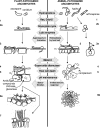Parallels in fungal pathogenesis on plant and animal hosts
- PMID: 17041185
- PMCID: PMC1694825
- DOI: 10.1128/EC.00277-06
Parallels in fungal pathogenesis on plant and animal hosts
Figures

References
-
- Albrecht, A., A. Felk, I. Pichova, J. Naglik, M. Schaller, P. de Groot, D. Maccallum, F. Odds, W. Schafer, F. Klis, M. Monod, and B. Hube. 2006. Glycosylphosphatidylinositol-anchored proteases of Candida albicans target proteins necessary for both cellular processes and host-pathogen interactions. J. Biol. Chem. 281:688-694. - PubMed
-
- Andrianopoulos, A. 2002. Control of morphogenesis in the human fungal pathogen Penicillium marneffei. Int. J. Med. Microbiol. 292:331-347. - PubMed
-
- Ausubel, F. 2005. Are innate immune signaling pathways in plants and animals conserved? Nat. Immunol. 6:973-979. - PubMed
-
- Bagga, S., and D. Straney. 2000. Modulation of cAMP and phosphodiesterase activity by flavonoids which induce spore germination of Nectria haematococca MP VI (Fusarium solani). Physiol. Mol. Plant Pathol. 56:51-61.
Publication types
MeSH terms
LinkOut - more resources
Full Text Sources
Medical

